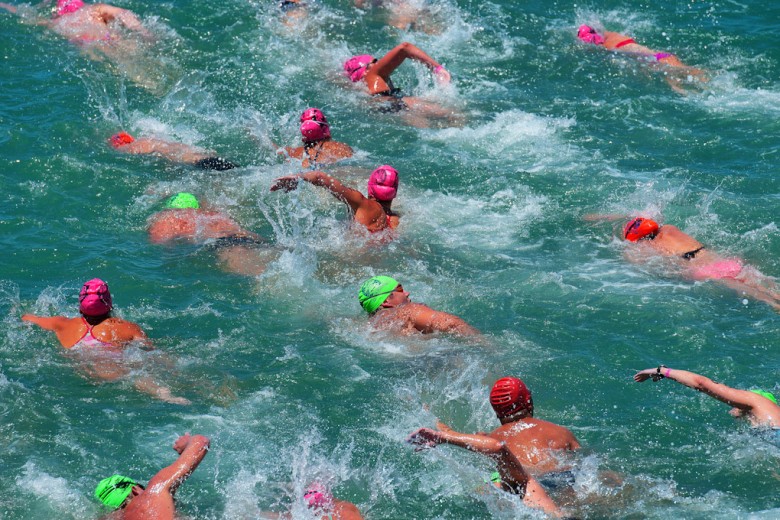Tomorrow the open water venue at the 2012 London Olympics will draw the biggest audience in the sport’s history. The Serpentine in Hyde Park is an extremely tight, six-lap course with open water analysts projecting record times for the men’s and women’s 10k marathon final. Fortunately the water temperature will hover at 68 degrees, slightly on the low-end of what is thought to be ideal race conditions.
Water temperature is a flashpoint issue in the open water world since the tragic death of Fran Crippen. The beloved world-class athlete lost his life due to hyperthermia during a 10k World Cup competition in Fujairah, south of Dubai.
During open water races athletes can suffer hyperthermia – the body producing more heat than can be dissipated – in water temperatures even as low as 77 degrees. Hyperthermia, as compared to the more commonly referred to hypothermia, is when the body temperature is too high, as compared to too low. Significantly high hyperthermia is considered a medical emergency. Athletes experiencing it must receive immediate treatment to prevent disability or death.
With over 6,500 open water races worldwide annually, very little data has been gathered on the effects of hyperthermia. It is surprising considering that twenty-three deaths can be partially attributed to hyperthermia. According to Steven Munatones, CEO of Open Water Source and a tireless advocate for athlete safety, “Over the past 18 years, there have been thirty deaths due to the hyperthermia…that I am aware of.”
Open water swimming is one of the fastest growing sports on Earth, and with more participants and older participants entering the sport every day, the occurrence of hyperthermia will surely increase.
United States Masters Swimming (USMS) Executive Director, Rob Butcher, is well aware of the issue and proactive about the safety of his swimmers. Rob has teamed up with Endless Pools to make long-lasting gains in our collective understanding of hyperthermia and it effects on swimmers. Together they are providing The Indiana University Counsilman Center with necessary equipment for a research facility. The USMS Grant Committee purchased an Endless Pool Elite for the Counsilman Center. Endless Pools provided the product and installation at cost. This joint effort is very focused, and, perhaps, best explained by Butcher:
“USMS is committed to creating a safe environment for our members,” he explained by phone. “Our purchase of an Elite Endless Pool and partnering with the IU Councilman Center for Swimming is an example. With this resource, the Center will be able to conduct controlled studies that could lead to new safety guidelines to be shared with the swimming community.”
Dr. Joel Stager, professor of Kinesiology at Indiana University and the Director of the Counsilman Center for the Science of Swimming, will conduct this vital research.
Alex Meyer, Team USA’s best hope for a medal in tomorrow’s Olympic 10k, is intimately familiar with the Endless Pool Elite model. When he broke his collarbone, he used this highly-engineered equipment for rehabilitation. He’s also closer to the incident that created the ongoing campaign to better understand hyperthermia. At the 10k World Cup competition in Fujairah, he waited for his friend Fran Crippen to come to shore.
Alex Meyer is dedicating his swim in London Olympic to Crippen.
You can watch both events, the men’s and the women’s 10k, at twelve noon. The women’s event is tomorrow. The Men’s event is Friday, August 10th. NBC will broadcast on their site live if you are a US cable subscriber.
For more information about Endless Pools go here.
WIN AN ENDLESS POOL by helping Endless Pools in their partnership with Swim Across America.



I’m sorry to point this out but Fran Crippen did not die of hypothermia in 30 C waters. Please do more research.
Tom – please read the paragraph again. It says “hyper”thermia, which is the opposite of “hypo”thermia.
Tom, it’s “hyper” not hypo. You know, a few friends emailed the same note. I think everyone just reads very quickly.
Yes, I see now. I must admit skimming the paragraph and stopping after that misreading.
Hopefully my ignorance and quick to judge attitude will prevent others making the same mistake.
This is a well written article and I stand at fault. Braden has even gone on to change it in order that people don’t jump to the same conclusions I did.
I think when a tragedy like this is involved people (myself) are too quick to get enflamed. Please accept my apologies.